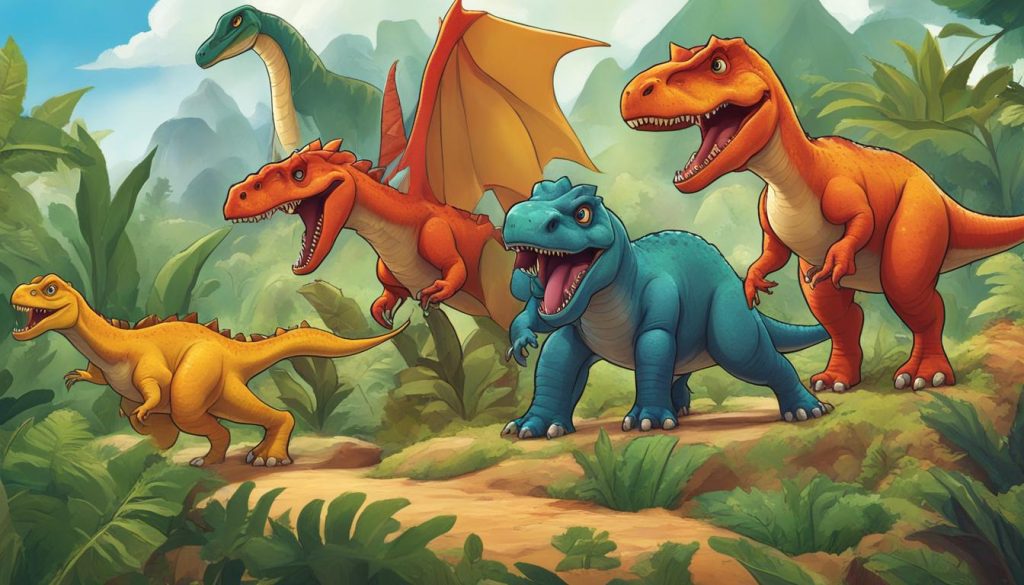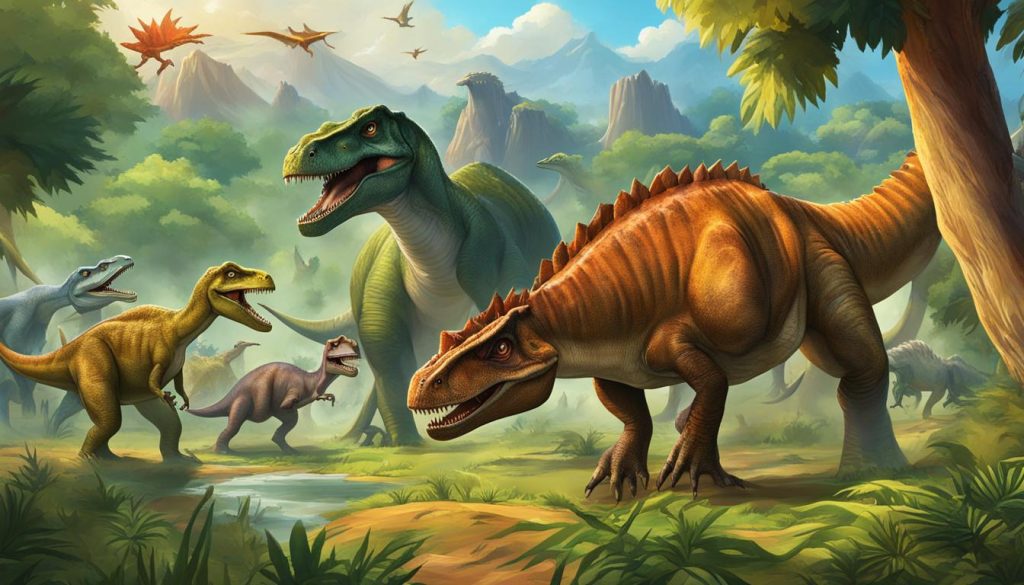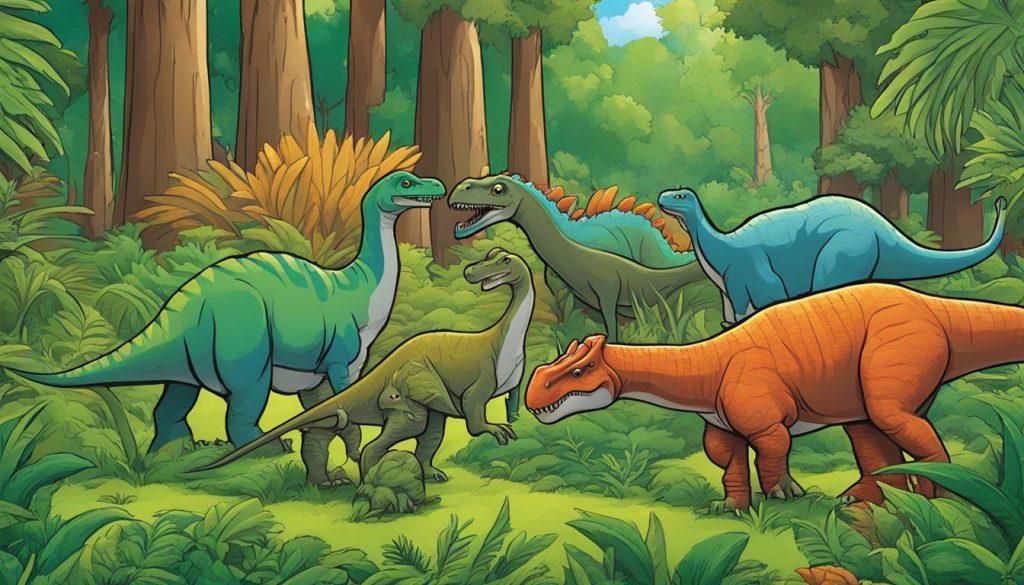Welcome to my article where we will embark on a journey to explore the fascinating world of dinosaurs! In this series, we will delve into the different types of dinosaurs, providing exciting dinosaur facts and information that will captivate children’s imaginations.
Let’s begin our adventure by uncovering the various types of dinosaurs that roamed the Earth millions of years ago. By understanding these different types, kids can gain a deeper appreciation for the diversity and evolution of these magnificent creatures.
From the fierce meat-eating theropods to the enormous plant-eating sauropods, and the bird-hipped herbivores known as ornithischians, each group has its own unique characteristics and role in the prehistoric world.
Throughout this journey, we will also explore the intriguing names and possible colors of these ancient creatures, sparking curiosity and expanding children’s vocabulary. Additionally, we’ll dive into the classification and evolution of dinosaurs, uncovering the connections and relationships between different species.
So, join me as we embark on an exciting adventure through time, uncovering dinosaur facts and information that will leave kids in awe. Let’s ignite their passion for paleontology and inspire their love for the natural world.
The Theropod Dinosaurs – Fierce Meat Eaters
Theropods, a group of meat-eating dinosaurs, have long captured the fascination of kids. These fierce predators roamed the Earth millions of years ago, leaving behind a rich fossil record for young paleontologists to explore. Some of the well-known theropod dinosaurs include the mighty Tyrannosaurus rex, the agile Velociraptor, and the formidable Spinosaurus. These dinosaurs varied in size, shape, and hunting strategies, making them a diverse and captivating group for children to learn about.
Engaging kids in educational games and activities related to theropods can be a fun way to ignite their curiosity. These games can involve naming different types of theropod dinosaurs, identifying their unique characteristics, or even simulating a hunt like a dinosaur would. By actively participating in these activities, children can not only have an enjoyable time but also deepen their understanding of these fascinating creatures.
“The world of theropod dinosaurs is one filled with excitement and awe. From the mighty jaws of the Tyrannosaurus rex to the razor-sharp claws of the Velociraptor, these creatures were perfectly adapted for the hunt.”
The Types of Theropod Dinosaurs
To provide a comprehensive overview of theropods, let’s take a look at a table showcasing some of the different types of theropod dinosaurs along with their key features:
| Dinosaur Name | Meaning of Name | Length | Weight | Diet |
|---|---|---|---|---|
| Tyrannosaurus rex | Tyrant lizard king | 40 feet | 8 tons | Carnivorous |
| Velociraptor | Swift thief | 6 feet | 33 pounds | Carnivorous |
| Spinosaurus | Spine lizard | 49 feet | 20 tons | Carnivorous |
As the table shows, theropod dinosaurs varied greatly in size and weight. This diversity allowed them to occupy different ecological niches and thrive in a range of environments. From the colossal size of the Tyrannosaurus rex to the nimble agility of the Velociraptor, theropods captivate the imagination of young dinosaur enthusiasts.
With the help of interactive games, captivating books, and engaging activities, kids can dive into the thrilling world of theropod dinosaurs and expand their knowledge about these magnificent creatures.
The Sauropod Dinosaurs – Enormous Plant Eaters
Sauropods were some of the largest and most magnificent dinosaurs that ever roamed the Earth. These enormous herbivores walked on all fours and had long necks and tails. They belonged to the group of dinosaurs known as sauropodomorphs, and they were characterized by their massive size and unique adaptations for feeding on plants.
Some of the well-known types of sauropod dinosaurs include Apatosaurus, Brachiosaurus, and Diplodocus. These giants of the prehistoric world were truly awe-inspiring, with some reaching lengths of up to 100 feet and weighing more than 100 tons. They had long necks that allowed them to reach vegetation high above the ground, and their small heads were perfect for stripping leaves from branches.
| Sauropod Dinosaurs | Size | Diet |
|---|---|---|
| Apatosaurus | Up to 75 feet long | Herbivorous |
| Brachiosaurus | Up to 85 feet tall | Herbivorous |
| Diplodocus | Up to 90 feet long | Herbivorous |
Exploring the world of sauropod dinosaurs can be an exciting adventure for kids. They can imagine what it would be like to stand next to these colossal creatures, marvel at their size, and learn about their herbivorous lifestyle. Dinosaur pictures and videos can bring these majestic giants to life, allowing children to see how they moved and interacted with their environment. Through visual materials, kids can develop a deep appreciation for the diversity and grandeur of the sauropods.
The Ornithischian Dinosaurs – Bird-Hipped Herbivores
The ornithischian dinosaurs were a fascinating group of herbivorous dinosaurs with hips that resembled those of modern birds. This group includes well-known dinosaurs such as Triceratops, Stegosaurus, and Iguanodon. Ornithischians had unique adaptations that allowed them to thrive as plant-eaters in the prehistoric world.
One of the most iconic members of this group is Triceratops. With its three horns and elaborate frill, Triceratops is a favorite among dinosaur enthusiasts. Its horns may have been used for defense against predators, while its beak-like mouth was perfect for ripping and grinding tough plant material.
Stegosaurus is another well-known ornithischian dinosaur. It had distinctive rows of bony plates along its back and a set of dangerous spikes on its tail. These plates may have been used for display or regulating body temperature, and the tail spikes could have served as a means of defense against predators.
Table: Comparison of Ornithischian Dinosaurs
| Dinosaur | Key Features |
|---|---|
| Triceratops | Three horns, frill, beak-like mouth |
| Stegosaurus | Bony plates, tail spikes |
| Iguanodon | Thumb spike, large thumb claw |
Iguanodon, on the other hand, had a unique feature – a thumb spike. This spike may have been used for defense or foraging. Iguanodon also had a large thumb claw that could have been used for digging up roots and other vegetation.
Dinosaur books and toys featuring ornithischian dinosaurs can provide children with an immersive learning experience. These educational resources can help kids engage with the different types of dinosaurs and stimulate their imagination. By exploring the world of ornithischians, children can develop a deeper appreciation for the diversity and wonder of prehistoric life.
The Diversity of Dinosaur Names
Dinosaurs have captivated the imaginations of children for generations, and one of the reasons is their intriguing names. Many dinosaur names are derived from Greek or Latin words and highlight the unique characteristics of each species. Learning about dinosaur names is not only fun but also a great way for kids to engage with the different types of dinosaurs and expand their vocabulary.
Some well-known dinosaur names for kids include Tyrannosaurus rex, Velociraptor, and Triceratops. These names evoke images of fierce predators and herbivorous giants, bringing to life the prehistoric world in which these creatures roamed. Encouraging children to learn and remember these names can spark their curiosity and fascination with dinosaurs.
“Learning about dinosaur names is like unearthing hidden treasures. Each name represents a unique dinosaur species with its own story to tell. It’s incredible to think that millions of years ago, these mighty creatures once ruled the Earth,” says paleontologist Dr. Emma Johnson.
As kids explore the diversity of dinosaur names, they begin to associate these names with specific types of dinosaurs. This helps them develop a deeper understanding of the characteristics and behaviors of different dinosaur species. Whether they are learning about the fierce theropods or the gentle herbivores, dinosaur names provide a connection to the rich world of prehistoric life.
| Dinosaur Name | Meaning | Type |
|---|---|---|
| Tyrannosaurus rex | Tyrant lizard king | Theropod |
| Velociraptor | Swift thief | Theropod |
| Triceratops | Three-horned face | Ornithischian |
Dinosaurs in Living Color
Dinosaurs, with their fascinating and often mysterious appearance, have captivated the imaginations of children and adults alike. While their skeletons give us clues about their physical characteristics, the coloration of dinosaurs’ skin remains a topic of scientific debate. Some scientists believe that dinosaurs were gray or green to blend with their surroundings, while others suggest that they were colorful and vibrant.
Fossils have shown that many species of dinosaurs had feathers, which could have served a variety of purposes such as insulation, camouflage, or display. These feathers, combined with the possibility of colorful skin, add a new dimension to how we perceive dinosaurs. Exploring the possible colors and appearance of dinosaurs can spark kids’ curiosity and creativity, allowing them to envision these ancient creatures in living color.
The Role of Feathers and Coloration
Feathers played a crucial role in the lives of dinosaurs. They provided insulation to keep warm in colder climates, helped with courtship displays, and possibly aided in communication between individuals. The discovery of fossilized feathers has revolutionized our understanding of the evolutionary relationship between dinosaurs and modern birds.
Feathers were not limited to birds; they were an integral part of many dinosaur species, providing them with unique adaptations and advantages in their environments.
Some researchers believe that feathers could have been brightly colored, similar to modern-day birds, to attract mates or establish dominance within their species. Others suggest that dinosaurs may have had colors for camouflage, allowing them to blend into their surroundings and avoid predators.
Dinosaur Pictures for Kids
Visual materials such as dinosaur pictures for kids can help bring these colorful creatures to life. Illustrations and reconstructions based on scientific findings allow children to see dinosaurs in their natural habitat, showcasing their potential coloration and distinct features. These images not only educate but also inspire young minds to engage with the world of paleontology and the wonders of the prehistoric era.
| Dinosaur Name | Color | Feathers |
|---|---|---|
| Tyrannosaurus rex | Gray or Green | Feathers |
| Velociraptor | Striped | Feathers |
| Triceratops | Various Colors | No Feathers |
By exploring the possible colors and appearance of dinosaurs, children can develop a deeper understanding and appreciation for these ancient creatures. The ongoing research and discoveries in paleontology continue to shed light on the diverse and vibrant world of dinosaurs, allowing us to imagine what these extraordinary creatures may have looked like in living color.
The Classification of Dinosaurs
When it comes to understanding dinosaurs, one key aspect is their classification. Paleontologists categorize dinosaurs based on their physical characteristics and evolutionary relationships. By organizing dinosaurs into groups, we can explore the diversity and evolution of these remarkable creatures.
There are two main types of dinosaurs: saurischians and ornithischians. Saurischians, also known as lizard-hipped dinosaurs, include the theropod and sauropod dinosaurs. Theropods, like Tyrannosaurus rex and Velociraptor, were fierce meat-eaters, while sauropods, such as Brachiosaurus and Diplodocus, were enormous plant-eaters.
On the other hand, ornithischians, or bird-hipped dinosaurs, were herbivorous dinosaurs with hips that resembled those of modern birds. This group includes well-known dinosaurs like Triceratops, Stegosaurus, and Iguanodon. By understanding the classification of dinosaurs, kids can get a glimpse into the different types of dinosaurs and their roles in the prehistoric world.
The Classification of Dinosaurs
| Type of Dinosaurs | Main Groups | Examples |
|---|---|---|
| Saurischians | Theropods | Tyrannosaurus rex, Velociraptor, Spinosaurus |
| Sauropods | Apatosaurus, Brachiosaurus, Diplodocus | |
| Ornithischians | Bird-Hipped Herbivores | Triceratops, Stegosaurus, Iguanodon |
By learning about the classification of dinosaurs, children can better understand the fascinating world of these prehistoric creatures. It opens the door to exploring the various types of dinosaurs, their unique characteristics, and the evolution of these ancient beings.

The Evolution of Dinosaurs
In the fascinating world of dinosaurs, understanding their evolution is key to unraveling their mysteries. Over millions of years, these incredible creatures underwent remarkable transformations, leading to the diverse types of dinosaurs we know today. Through the study of shared characteristics, paleontologists have organized dinosaurs into different groups, shedding light on their ancient history.
By examining the relationships between dinosaur species, scientists have classified them into distinct groups. These classifications help us understand the evolutionary pathways taken by various types of dinosaurs. From fierce theropods to enormous sauropods and bird-hipped ornithischians, each group showcases unique adaptations and characteristics that allowed them to thrive in different environments.
Children can embark on an educational journey, learning about the major dinosaur groups and how individual species are classified within them. Discovering the evolutionary links between dinosaurs enables kids to delve deeper into the wonders of ancient life on Earth. Through this exploration, children can expand their knowledge of dinosaur facts and develop a greater appreciation for these remarkable creatures that once roamed our planet.
FAQ
Can you provide some examples of theropod dinosaurs?
Sure! Some well-known theropod dinosaurs include Tyrannosaurus rex, Velociraptor, and Spinosaurus.
What were the characteristics of sauropod dinosaurs?
Sauropod dinosaurs were massive herbivores that walked on all fours, had long necks and tails, and were the largest land animals that have ever lived.
Which dinosaurs belong to the ornithischian group?
Dinosaurs such as Triceratops, Stegosaurus, and Iguanodon are part of the ornithischian group, which were herbivores with hips resembling those of modern birds.
How did dinosaurs get their names?
Many dinosaur names are derived from Greek or Latin words and highlight unique characteristics of each species.
What colors did dinosaurs have?
The coloration of dinosaurs’ skin is still debated among scientists. Some believe they were gray or green to blend with their surroundings, while others suggest they were colorful.
How are dinosaurs classified?
Dinosaurs are classified into saurischians (lizard-hipped dinosaurs) and ornithischians (bird-hipped dinosaurs) based on their physical characteristics and evolutionary relationships.
How long did dinosaurs live on Earth?
Dinosaurs lived on Earth for millions of years and underwent remarkable evolution before becoming extinct.





